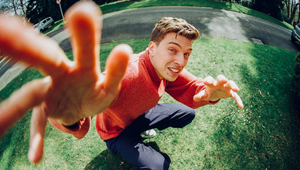
Madonna Celebrates the Power of Music and Strength of Women with ‘Batuka’ Promo

COMPULSORY director Emmanuel Adjei has directed the music video for Madonna's latest single, ‘Batuka.’
Adjei’s video is a heartfelt expression of the power of music to cross boundaries, to raise spirits, and to heal. Furthermore, the video, produced by COMPULSORY in London and Dreamers in Paris, is a brilliant departure for Madonna, as it documents her relationship with her collaborators on the song – the Orchestre Batukadeiras, the all-female, multi-generational orchestra and choir who perform the centuries-old Cape Verdean musical tradition of batuque.
When she moved to Lisbon a couple of years ago, Madonna discovered the Portuguese Orchestre Batukadeiras, and the call-and-response vocal style and polyrhythms of batuque – said to have originated in Cape Verde at the start of the slave trade, by the first African slaves about to be transported to America. Madonna recorded ‘Batuka’ with the Orchestre Batukadeiras in January for Madame X, her 14th studio album. The Orchestre are now accompanying Madonna on her tour.
At the end of last year, when he was called by Madonna to talk about creating a video for one of the tracks from Madame X, Emmanuel Adjei picked two songs from the album. The first was ‘Dark Ballet’ – resulting in the searingly dramatic video featuring singer Mykki Blanco as Joan of Arc, released in June. The other song was ‘Batuka.’
Just as Adjei’s video for Dark Ballet was unconventional for a Madonna video – the Queen of Pop appears in only one shot, and Mykko Blanco effectively represents her on screen – his visual for Batuka is groundbreaking for another reason. Arguably no music video, in more than 70 videos that Madonna has made in her incredible career, has been more like an authentic document of a real event.
Adjei, a Dutch director of Ghanian descent, says that he felt emboldened to make a Madonna video unlike any other, because of the history of the Batukadeiras and their connection to the tragedy of slavery. “While Dark Ballet is perhaps closer to Madonna’s backstory, the Batukadeiras touched me on a cultural level,” he says. “Hearing those voices of these Batukadeiras together with Madonna made me feel empowered to make a video for this track.”
Filmed just outside Lisbon, on a spectacular cliffside overlooking the Atlantic, Adjei’s film for ‘Batuka’ starts by focusing entirely upon the women of the Orchestre: a series of portraits of their faces, old and young, as they sing, beat out rhythms on drums, walk, and stand on their clifftop, looking out to the direction of Cape Verde. They are imagining the ships that took their men away to the Americas centuries before - which are finally glimpsed in the last moments of the video. We discover something about their character, spirit, resilience, and their solidarity.
As we hear Madonna participating in the call and response of the batuque, she becomes increasingly visible, among the women of the Orchestre Batukadeiras. Distinguished from the white-garbed women in her striking green and black dress, she assumes the role of honoured guest within their world, in and around their communal building.
The real achievement of Adjei’s video for ‘Batuka’ is to capture this unexpected meeting of different musical talent in such an evocative way and authentic way. We sense the genuinely exciting results of their collaboration, and the sense of joy and happiness that comes from that - expressed both by members of the Orchestre, and by Madonna herself.
After performing together, and as they congregate and ‘group hug’ towards the end of the video, there is a palpable sense of warmth between Madonna and the Batukadeiras - not just as fellow musicians, but as women. Madonna has been welcomed into the solidarity of the group.

Emmanuel Adjei says that the original idea for the ‘Batuka’ video was to film Madonna and the Batukadeiras separately, to emphasise the call-and-response pattern of the track. “Then on set we realised they couldn’t be separated. Madonna said: ‘Even though I love the concept I realise I have to be with these women from the first shot to the end. We have to rejoice and we have to suffer at the same time.’”
“So all the things you see on screen happened on set. I guess if feels so genuine because Madonna was reconnecting with these women. I felt that and thought – ‘let’s try to capture those moments’ – while at the same time we still have the Batukadeiras’ backstory.”
Adjei, who is best known for his music video and short film work with the Dutch-Iranian artist Sevdaliza – including the award-winning video for Shahmaran, released last year – filmed the videos for ‘Batuka’ and ‘Dark Ballet’ over four days in Portugal in March. COMPULSORY, Adjei’s London production company home, and Dreamers, his French base, worked with local Portuguese producers Ready To Shoot to produce the two videos within this tight schedule – flipping between the two shoots on successive days.
Chris Toumazou, executive producer at COMPULSORY, points out that this required Adjei to switch between styles of directing on a daily basis, as the demands of ‘Dark Ballet’ and ‘Batuka’ were so completely different. “One day Emmanuel would be shooting a house on a cliff top for Batuka, and the next day we'd be doing a much more structured and composed day shooting at national monuments for Dark Ballet,” he says.
“Having worked with Emmanuel from his early projects, it's clear to see that the vision as he's defined himself as an artist has never changed, but that his work has continued to scale and grow,” adds Chris. “It's interesting to see that Batuka comes out as a very different place to her previous works. We always imagined it to be more personal, and I think what the video shows best is how genuine her relationship with the Batukadeiras and with Emmanuel.”










